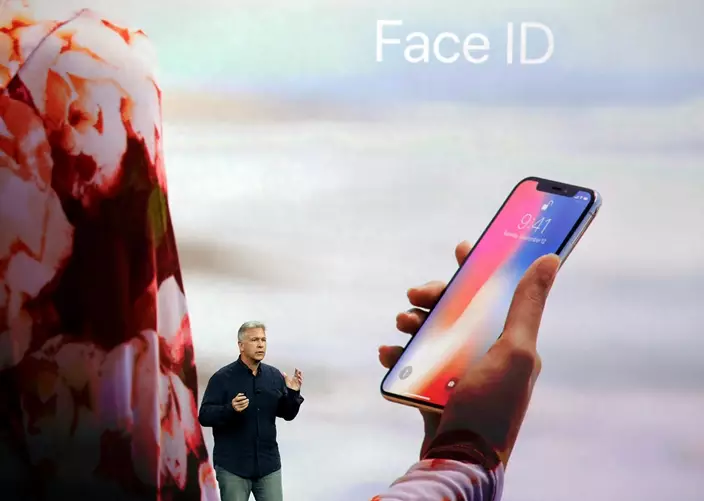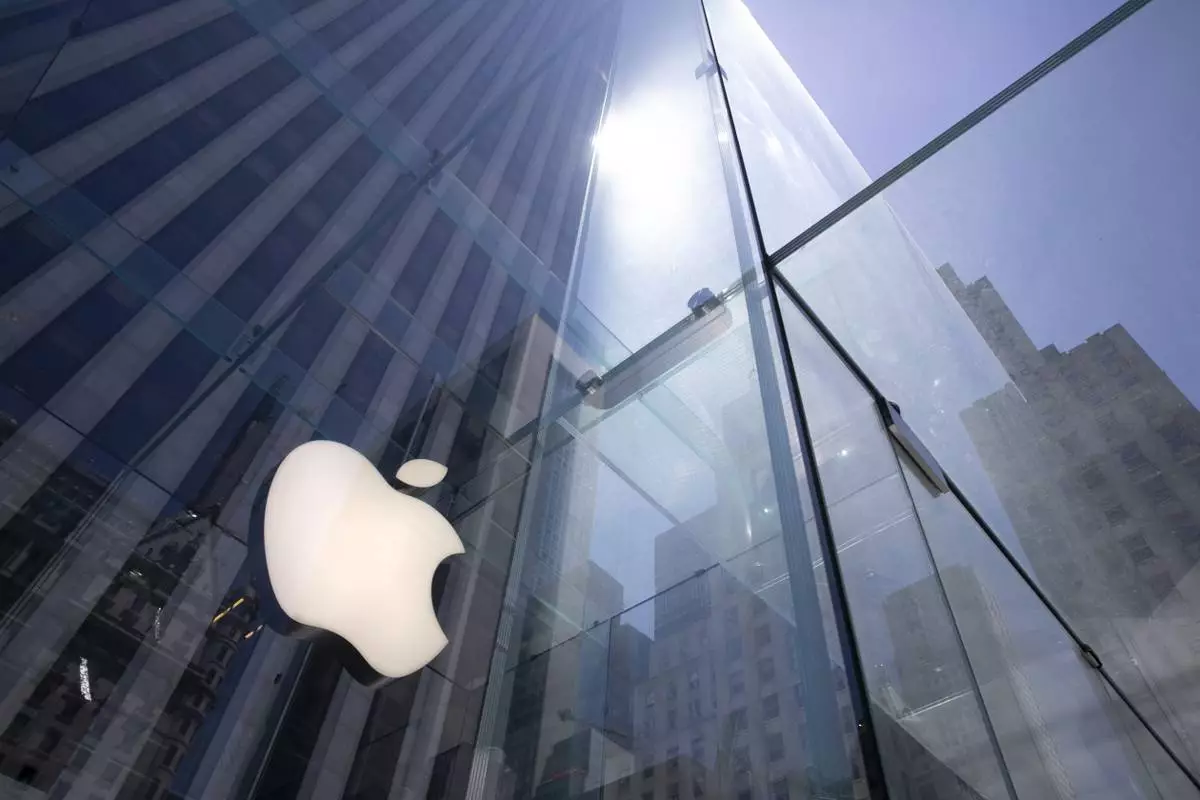In mid-September, Apple unveiled its new Face ID facial recognition system , which is due to debut with the iPhone X on Nov. 3. The system lets users unlock their phones just by glancing at them, but has also raised privacy questions and some anxieties over whether someone could force you to unlock your phone by pointing it at your face.
On Wednesday, Apple offered some in-depth explanations about the pains it's taking to protect your privacy in an update to its website.
Here's what you need to know about how Face ID works and the precautions Apple has taken for privacy and security.

FILE - In this Tuesday, Sept. 12, 2017, file photo, Phil Schiller, Apple's senior vice president of worldwide marketing, announces features of the new iPhone X, including Face ID, at the Steve Jobs Theater on the new Apple campus, in Cupertino, Calif. (AP Photo/Marcio Jose Sanchez, File)
HOW DOES FACE ID WORK?
Face ID captures both a 3-D and 2-D image of your face using infrared light while you're looking straight at the camera. Apple then compares that information to images you took while setting up Face ID; that comparison is done using a "neural network" that lives on the iPhone X's new A11 chip.
Five unsuccessful attempts at Face ID will force you to enter a passcode — which you'll need anyway just to set up facial recognition. That requires you to come up with a secure string of digits — or, for extra security, a string of letters and numbers — to protect your privacy.
DOES IT WORK?
It didn't during Apple's Sept. 12 event — at least initially, when senior vice president Craig Federighi tried and failed to demonstrate Face ID for the crowd before switching phones. Apple explained that handlers mistakenly set off Face ID attempts prior to Federighi's presentation, which caused the phone to revert to a passcode lock before he took the stage.
While Face ID won't face an acid test with ordinary users until November, Apple says it should work just fine.
IS APPLE GOING TO STORE MY FACE IN THE CLOUD?
Relax, Apple says. Your face isn't leaving your device.
The iPhone X will store representations of your face in its "secure enclave," a hardware-based enclosure designed to be resistant to spying and tampering. The phone-based neural net processing means the image representations never have to go anywhere.
The iPhone X allows does allow third-party apps to let you sign in via Face ID, but these outside developers only receive notifications from Apple that you've been authenticated or not. Other apps "can't access Face ID or the data associated with the enrolled face," the company said in its security white paper.
The only time your images can leave the phone is when you call Apple's support service, AppleCare. If you're having trouble with Face ID, you can select which images you want to send for diagnostics, the company said.
CAN A BORDER GUARD/JEALOUS SPOUSE/TRAFFIC COP UNLOCK MY PHONE BY POINTING IT AT ME?
Maybe — although Face ID only works if you're looking at it. So turning away is one emergency measure you could take.
Apple has also provided a panic button feature. Simultaneously squeeze the iPhone X's power button and either volume button for two seconds, and it will temporarily disable Face ID by turning the phone off. Just as with Touch ID, the phone requires a passcode after a restart. The process essentially turns your phone into a brick for anyone who doesn't know your passcode.
SUPPOSE I SHAVE MY HEAD OR GROW A BEARD? WILL MY PHONE STILL KNOW ME?
Apple says its algorithms learn to adapt to appearance changes over time. The system keeps recent images and uses them to allow unlocking if they are close enough to the registered image.
But if you undergo a sudden changes in appearance — like shaving a beard, for instance — the phone will only add the new image to its library if you follow a failed Face ID attempt by immediately entering your passcode.
Apple on Thursday disclosed its steepest quarterly decline in iPhone sales since the pandemic’s outset, deepening a slump that’s increasing the pressure on the trendsetting company to spruce up its products with more artificial intelligence.
The 10% drop in year-over-year iPhone sales for the January-March period is latest sign of weakness in a product that generates most of Apple’s revenue. It marked the biggest drop in iPhone sales since July-September period in 2020, when production bottlenecks caused by factory closures during the pandemic resulted in a delayed release of that year's model.
The current iPhone downturn was the main reason Apple’s revenue for the latest quarter decreased 4% from last year to $90.8 billion. It marked the fifth consecutive quarter that Apple’s revenue dipped from the previous year. Apple’s profit in the past quarter totaled $23.64 billion, or $1.53 per share, a 2% dip from last year.
But both Apple's revenue and earnings per share came in slightly above analysts projections, according to FactSet Research. Apple also predicted its revenue for the April-June quarter will rise modestly from a year ago, which would end the recent streak of erosion.
Part of the iPhone deterioration during the first three months of the year stemmed from a big boost in sales during the same period last year when Apple said it was filling pent-up demand caused by pandemic-driven shipment delays.
Even as it stumbles slightly, Apple remains one of the world’s most prosperous companies. The Cupertino, California, company hammered home that point by announcing a 4% increase in its quarterly dividend to 25 cents per share. The company also committed to spending $110 billion buying back its own stock, a move that investors cheered but may fuel criticism that Apple is spending more money catering to Wall Street than creating more innovative products.
Bolstered by the increased dividend and stock repurchase commitment, Apple's shares rose nearly 7% in extended trading after the news came out. The stock price has fallen 10% so far this year, erasing about $300 billion in stockholder wealth.
Although investors have been dismayed by the weakening iPhone sales, they are also concerned Apple may be losing its edge as other tech giants such as Microsoft and Google sprint out to the early lead in artificial intelligence technology that is expected to reshape the industry and technology.
The latest quarterly report “leaves no margin for doubt about Apple’s current state of affairs,” said Investing.com analyst Thomas Monteiro. “More than ever in the past decade, the company needs new products and solutions.”
Apple is widely expected to unveil more AI services in June during an annual conference showcasing the next version of its software for the iPhone and Mac computers.
“We believe in the transformative power and promise of AI and we believe we have advantages that will differentiate us in this new era,” Apple CEO Tim Cook assured analysts during a Thursday conference while promising more details will be announced soon.
Weak sales in China were again a factor in the latest quarter, with revenue in that region falling 8% from last year to $16.37 billion as rival smartphone makers gained ground in one of the company’s largest markets. Even so, analysts had been anticipating an even bigger sales decline in the results, providing investors with a measure of relief.
Apple had a few bright spots in the past quarter too, most notably in its service division, which saw its revenue rise 14% from the year before to $23.87 billion.
The division reaps a significant portion of its revenue from a lucrative deal that locks in Google as the search engine that automatically answers queries on the iPhone — an arrangement that is a focal point of an antitrust trial currently wrapping up with closing arguments in Washington this week.
Commissions collected on digital transactions within iPhone apps are also a major revenue source within Apple’s services division, an area being targeted in a U.S. Justice Department lawsuit alleging the company is running an illegal monopoly that locks out competition to the detriment of consumers.
That case is expected to take several years to resolve, but European regulators already are forcing Apple to allow more alternatives to its proprietary iPhone app store as part of the Digital Markets Act.

FILE - In this June 16, 2020 file photo, the sun is reflected on Apple's Fifth Avenue store in New York. Apple will reports earnings on Thursday May 2, 2024. (AP Photo/Mark Lennihan, File)











